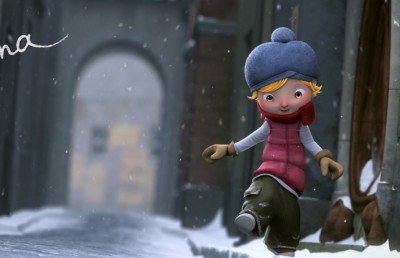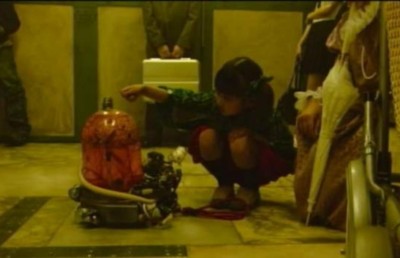An Interview with Higashi Yoichi
Fuon
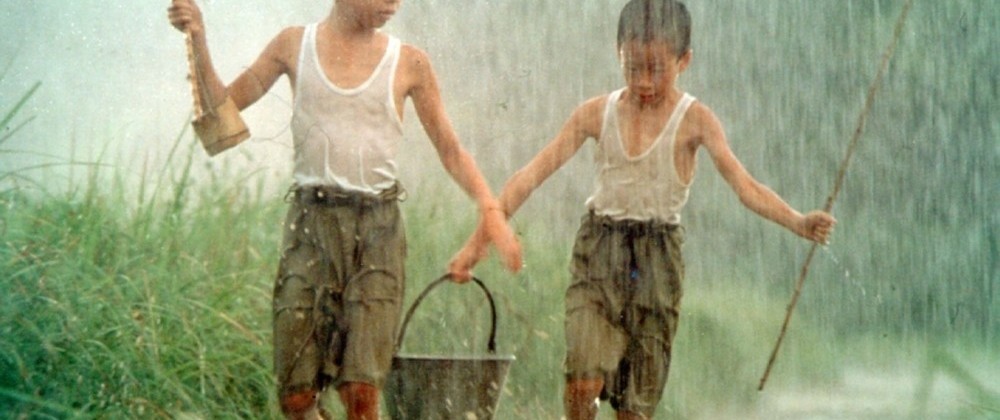
On the occasion of Fuon (The Crying Wind, Japan, 2004, 106 mins.) showing in competition at the 2004 Festival des Films du Monde (World Film Festival), in Montreal, the director of the film, Higashi Yoichi, along with principal actor, Uema Muneo, and Yamagami Tetsujiro, the film’s producer were interviewed by Peter Rist for Offscreen. The translation was by David Lewis with the able assistance of Anne McKnight. Without their help, this interview would not have been possible.
Higashi Yoichi was born in Wakayama Prefecture in 1934. He graduated from Waseda University’s Department of Literature. Higashi went freelance after working at Iwanami Film Production Company. His first feature film was a documentary, Okinawa retto (The Okinawa Islands, 1969). This was followed by Yasashi Nippon jin (The Gentle Japanese, 1971), a drama that won the Directors Guild of Japan New talent Award. His Hashi no nai Kawa (River with No Bridge, 1992) was a major hit, seen by over two million viewers in Japanese theatres. E no naka no boku no mura (Village of Dreams, 1996) won the Silver Bear prize at Berlin along with many other domestic and international awards. His most recent film prior to Fuon is Watashi no guranpa (My Grandpa, 2003), an entertaining drama which appeals to all ages and which won the first Golden Zenith, people’s choice award for “Best Asian Film,” at the 2003 World Film Festival.
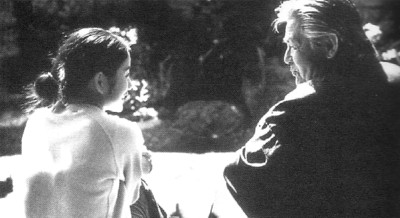
Synopsis of Fuon:
Toma Seikichi, 70, makes his living fishing from a small boat off the coast of Okinawa. He and his 12-year-old grandson Akira live in a small, tree-lined village in the northern part of the island which is surrounded by a white-sand beach and plots of pine and flowering bushes. On the cliff that skirts the shore sits an open-air burial ground containing the skull of a kamikaze pilot who was shot down during the last days of World War II. When the wind blows through the bullet hole in the skull, it produces a whistling sound. The locals call it the “Crying Head.” It was Seikichi’s father who brought the pilot’s corpse onto the shore during the fighting, an event that Seikichi still remembers well. One day in spring, Shimazaki Kazue, 30, returns to the village with her son Masashi, 10. She has fled her abusive husband and has returned to live with her aging mother, Makato. Akira befriends Masashi, introduces him to the other boys of the village and shows him how to fish with a bamboo pole. Soon afterwards, Fujino Shiho, 70, comes to the village from the mainland of Japan. Long ago, the man she loved, Kano Shin’ichi died as a kamikaze pilot during the battle of Okinawa and she has returned periodically to find what happened to his body. As his father had lain Shin’ichi’s body to rest in the burial ground, Seikichi stole a fountain pen that fell from the pilot’s clothes and he still feels guilt about it today. Shiho pays a visit to Seikichi to ask him about the crying wind but he remains silent and will not respond. Meanwhile Kazue’s violent husband has followed her to the island, and in defending herself, he is killed. Seikichi witnesses this act but doesn’t inform the police, and, he takes Kazue and Masashi away from the village, down to the main city of Naha. Shiho decides to return to Tokyo and says goodbye to Seikichi. In the taxi, she quietly tears up the letter from Shin’ichi that she has treasured all these years. She throws the small pieces of the letter out of the window into the sea. The fragments dance in the wind and some fall into the sea, but others ride the wind and are carried off far into the distance. Old Cut-Ear, a mysterious old man, standing outside his house looking up into the sky, blows a puff of breath at a pinwheel in his garden. As he does, the wind swirls around him and catches the falling fragments of the letter and sends them dancing into the sky. One piece flutters down next to the crying skull. On it is written the name Shiho, written long ago by Shin’ichi. As it settles, the wind rises and from the skull that once lived as Kano Shin’ichi the sound of the crying wind again begins to reverberate. The sound rings through the village and reaches Akira and the other boys at their fishing hole. In wonder, the boys turn their ears to the remarkably strong sound of the crying wind. Seikichi is standing inside the burial ground, the source of the crying wind. He has just buried the fountain pen in the cave, along with the knife that was involved in the tragedy that unfolded. He presses his hands together and prays to the skull, “Please watch over those,” as large, white butterflies cluster and fly around him…(Peter Rist).
Offscreen: My first questions are on Okinawa, for Higashi-san, why is he so interested in Okinawa, and for Uema-san, is he from Okinawa and did Higashi-san meet him on the island?
Higashi Yoichi (HY): There are many reasons, but for today, I will give you one. Okinawa is a place that represents all the problems of Japan, from very old problems to very modern problems, and all of these problems are included within the film. It concentrates all of these aspects which were present in my very first film [being a documentary], on the old Japanese mentality [the old way of thinking] which is more present in Okinawa, more so than anywhere else [in Japan]. And at the other end of the spectrum is the political situation with respect to the war and the American presence in it, so everything is included… And this is not something exclusive to this film, it is a situation I have been interested in since the start of my film career.
Uema Muneo (UM): I was born and raised in Okinawa. I have always lived there. The film was made in my home village and that is how we met. I am a civil servant, a kind of local master, village master.
Offscreen: Are you a good swimmer and a fisherman?
HY: It was important that I had a person in the film who was a good swimmer and someone who could dive for fish, and Uema-san had been doing that since he was a youngster.
UM: So it is very natural for me to do those things in the film.
HY: It was very important for me to have a natural performer who could swim and fish and dive, rather than to hire a famous actor and fake it.
Offscreen: And the age of the character in the film that Uema-san plays [Toma Seikichi] is about 70, and I was surprised to find that Higashi-san’s actual age is similar, so is there a kind of autobiographical element to this role?
HY: Even though there is closeness of age, there is absolutely no connection. I have never been a fisherman, for example.
Offscreen: Fish also seem to be important in Village of Dreams. Fish are a recurring symbol or motif in your films, perhaps?
HY: In Okinawa, fish, other animals and humans are not differentiated in some ways and I like this mentality. Fish in themselves are not used symbolically, rather they are used to represent humans in a kind of an animist way, but, my approach is not a true “animism.”
Offscreen: Yes, and in Village of Dreams there is a catfish which virtually walks on the road and manages to go back into nature, a kind of a human fish…
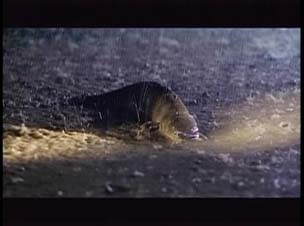
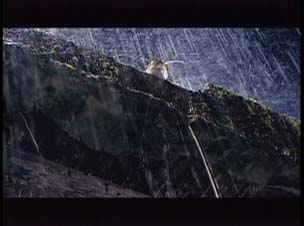
HY: I asked Uema-san from the very start about the war, about his different experiences with that, yes.
Offscreen: In all three of your films that I’ve seen, Fuon, Village of Dreams, and, My Grandpa, there is a use of many different generations, and what is especially prominent is the relationship between children and their grandparents. Women of all ages seem to be very positive figures, but, adult men are not necessarily positive, so, if you could talk a bit about your use of the different generations.
HY: This is not a direct answer, but, yesterday there was a review of my film in a local newspaper La Presse which said that the problem with the film is that you couldn’t tell if it was for children or adults. And, I think this is very silly because in every child there is the old person living within him and within every adult there is the child. Children are present in all of us. I am kind of sandwiching everything into an old and a young person…
Offscreen: In Fuon, all of the characters have mixed (good and bad) characteristics, but there is only one totally negative character in the entire film and that is the adult male character.
HY: Even though the character is very negative, they don’t hide the corpse, they give him the proper funeral rites.
Offscreen: I thought that was a great comment you made about the La Presse article because in North America they divide films into categories of “films for children” and “films for adults” whereas in Japan and Taiwan with Hou Hsiao-hsien and in Iran with Abbas Kiarostami they make films about children for everybody.
In all three films there is a very positive representation of nature which is almost like documentary, so we see the snake moving along a tree branch, we see the crab, and so on… But then there are kind of “magical moments” as well, perhaps not so much in Fuon, but in the other two films there is a lot. We have a combination of the natural and the magical, e.g., the catfish walking along the road.
HY: All films, from the very beginning of cinema are both natural and magical, I think. As an example, in Fuon, the man who cuts hair, when he blows on the windmill, that is a “magical moment.” Even when a film is “realist,” fantasy and illusion are an integral part of it, and that’s how “magic” appears. In film anything can happen in reality, and via “realism” can enter into the world of the film. And that is not my own idea, per se, but that’s how I regard great films. The best filmmakers are able to combine reality and illusion, for example, in both Carl Dreyer’s Ordet and Ingmar Bergman’s Cries and Whispers, someone comes back from the dead. (Jokingly, “I’m still imitating them.”)
Offscreen: Memory and flashback are strong components of all three of your films that I’ve seen. If you could talk a little about the strong presence of these in your films…
HY: It may be apparent in my earlier films, but working on Fuon I learned from the people of Okinawa that humans don’t live without memory, they live “on top of” memory. Memory is not really the past, it is the present. I have held this kind of concept of time, myself…
Offscreen: Which is why you are a filmmaker, probably (laughing)…
HY: Many film directors will show scenes from the past in monochrome, and that shows that for them the past is in the past, but, I don’t understand this, because for me everything is in the present. There is a concept in Japanese society where people who are older than you are above you in some way… But some people can seem to be 150 years old in terms of the memories they have of the past. In Okinawa temporality is layered and stretched out as if people there have lived longer (and more richly) than elsewhere. But by contrast, in Tokyo, yesterday is long gone, it is past history. In Okinawa the past is much more present.
Offscreen: Something I don’t like about contemporary Japanese “art” films is the incessant use of a “tinkling” piano, and so I can say that I’m so happy that you don’t do this, and, in fact, your soundtracks are very interesting. For example, in Village of Dreams, you combine ancient music with European “classical” art music while in Fuon there are three distinctly different kinds of music.
HY: When I’m shooting a film I don’t put the image or sound in front or on top of the other. When I’m shooting (which comes before the design of the soundtrack), I have a concept of the music and the other sounds in my head. But, I don’t make “soap operas” so I don’t “direct” the sound to manipulate the audience with its “special effect.”
Offscreen: I should emphasize that the one thing that I really don’t like about serious contemporary Japanese films is this minimalist piano, which drives me crazy, and maybe it does come from soap operas…
HY: It is probably a Hollywood influence, too.
Offscreen: I believe that you started making documentary films in Okinawa, and maybe Mr. Yamagami, your producer would like to say something about this early work.
Yamagami Tetsujiro: I established my company, Siglo, 18 years ago. Higashi-san’s first film was a documentary shot in Okinawa, which was called Okinawa Archipelago and was made in 1969. Higashi-san became well known after directing that documentary, and I’ve seen all of his films that he’s made since. But we didn’t work together until 1990 when I produced Hashi no nai Kawa (The River without a Bridge) and we have worked together on all the films since. We work very well together. I’ve produced about 50 documentaries [at least one of which was made in Okinawa], and I like them to look like fiction films. When I work with Mr. Higashi on fiction films, they become like documentaries. And I really like to produce films which lie between the two “genres,” documentary and fiction. I’m very happy to be able to do this with Mr. Higashi.
HY: The only problem is that my films do not become “hits.” The following is a very simple comment, but, for me, all films are “documentaries.”
Offscreen: I’m curious about your sense of morality and legality, which seems somewhat enigmatic. For example, someone might kill someone, and yet we can become very sympathetic towards that person because the killing seems justified (this is the case in both Fuon and My Grandpa), and another example which is both enigmatic and mysterious is Uema-san’s decision not to give the pen to the woman in Fuon. I wouldn’t normally ask such a question, but I am curious,… this time (laughter).
As an audience we develop a different sense of legality. We are not manipulated emotionally, like in Hollywood films, but there seems to be the development of a different moral system, which seems almost natural.
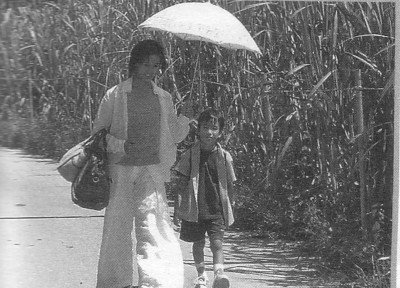
HY: Within Buddhism there is the sense that criminals and non-criminals are not divided, per se, by their acts, directly. The kind of negativity of being a criminal isn’t something you want to get rid of and segregate but the kind of negativity that you end up keeping and living off. On the example of the pen, there is no such thing as the “right thing” to do. Let’s hear what Uema-san has to say…
UM: First of all, Seikichi wanted to take all the responsibility for what had happened by himself, and then at first I was worried about what would happen to Fujino Shiho, what would happen in the future if he gave her back the pen (including the future of their relationship, whatever that might be), knowing that it would also break the relationship between Seikichi and the dead man.
HY: There are a lot of important little links involved: Fujino Shiho is on a trip, because she has cancer and might be dying, and the purpose of her trip has nothing to do with the pen. If Seikichi gives her the pen, then the film would become like the resolution of a detective story, where everything suddenly comes together and makes sense, and I didn’t want this effect, and it would possibly negate the whole trip idea. Now on a larger scale, in Western culture where there is a god, the journey is all about the start and the finish, basically, its all a teleology towards death, whereas in Eastern culture, there is more of a “step by step” travel (in life’s journey). That’s my perspective as a film spectator rather than as a director, and it is Seikichi’s point-of-view, also.
Offscreen: Did getting the Silver Bear at Berlin for Village of Dreams have a profound effect on your career?
HY: There were two important results. One is that many more people in Japan saw the film after hearing about the award—it gave them an impetus to see it—and the second is that I was able to get in touch with many other film directors and film people all over the world, like your friend Rudiger Tomczak.
Offscreen: On style and influences: it seems to me that the beauty of your films is very much familiar in terms of the history of Japanese cinema, but your style is not as rigorous or as formal as someone like Ozu or Shimizu from the past. Could you talk a little about this issue and also about your influences. More and more we are becoming aware of Japanese films of the 1930s, like those of Ozu and Shimizu, and we are discovering that they may have been the best in the world at this time. I’m interested in the possibility of these films influencing your work and how you relate to other Japanese directors of your own generation, and filmmakers from elsewhere (you’ve mentioned Bergman and Dreyer, for example). Do you feel an affinity with Hou Hsiao-hsien, for example?
HY:I have a bad habit of not agreeing with other people on which films are “good” or “bad.” There is no direct influence on my work from films of the 1930s which are supposed to be good (neither from films which are supposed to be bad). The directors I respect the most are those directors who are the least likely to influence me, or whose work I’m least likely to try and imitate, for example, Lars von Trier’s Dogville. There are hundreds of directors who have influenced me, but, again I would say that perhaps I respect those the most whose work I don’t want to be influenced by (laughter).
Offscreen: I hope your film wins some kind of prize but, I must say that the best films in competition here never win the top prize, and, actually the same applies to Cannes, also. Good luck.
PS: Fuon won the Innovation Award for “its poetic quality”!!!



